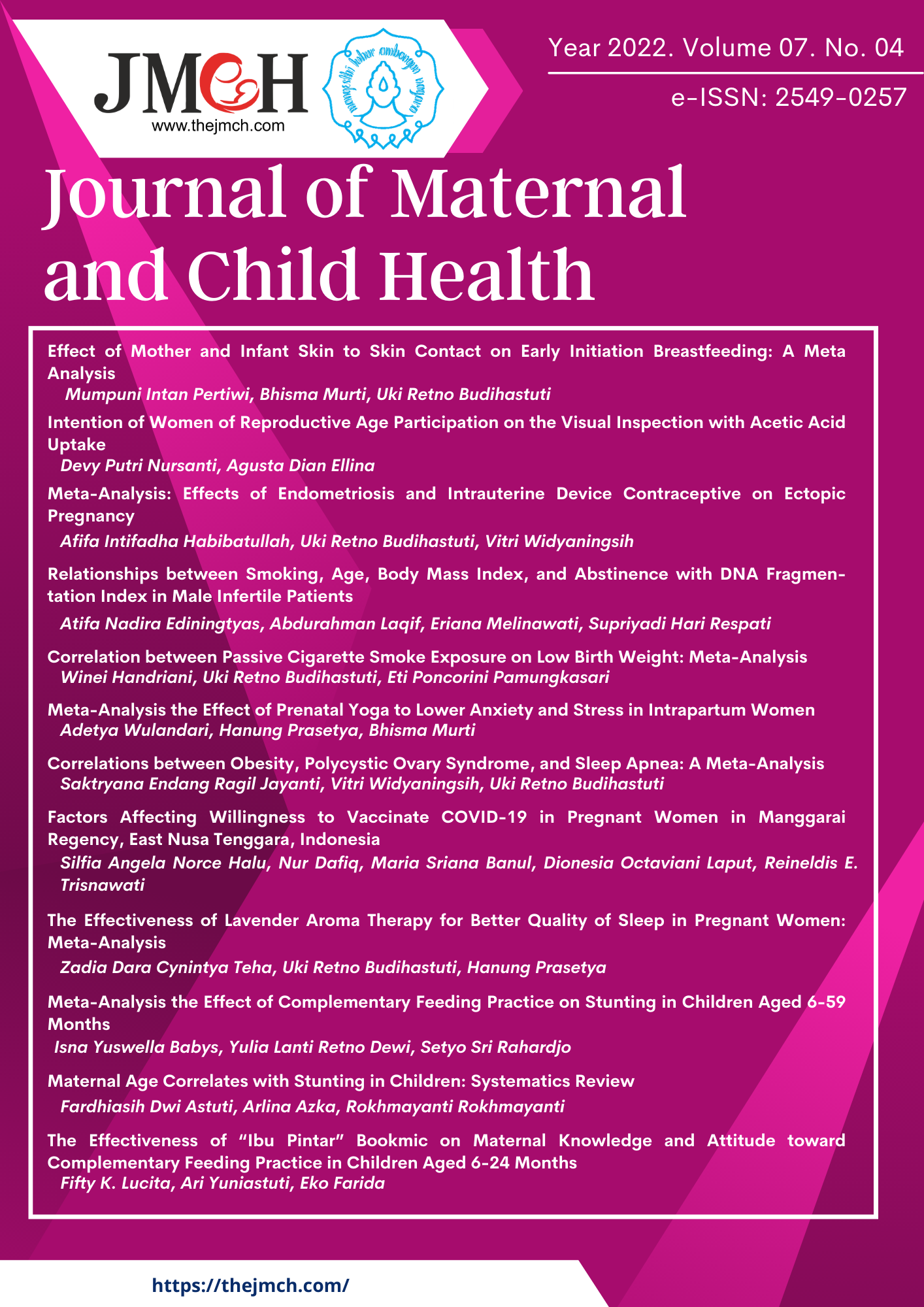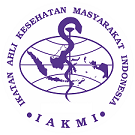Relationships between Smoking, Age, Body Mass Index, and Abstinence with DNA Fragmentation Index in Male Infertile Patients
DOI:
https://doi.org/10.26911/thejmch.2022.07.04.04Abstract
Background: Low birth weight (LBW) is defined as a newborn baby weighing less than 2500 grams. Low birth weight is a serious condition in developing countries. The impact of cigarette smoke on pregnant women who are exposed to cigarette smoke is at a higher risk of complications, such as miscarriage, premature birth, or babies born with low weight. This study aims to analyze the relationship between exposure to secondhand smoke and low birth weight.
Subjects and Method: This research is a systematic review and meta-analysis by systematically reviewing primary articles from Pubmed, Google Scholar, Scient Direct and Springerlink by selecting articles published in 2012-2022. The articles searched using PICO were P: Pregnant women, I: exposed to cigarette smoke, C: not exposed to cigarette smoke, O: low birth weight. Keywords "Exposure to smoking pregnant women" OR "Expectant mother" OR "Pregnancy women" OR "Exposed to cigarettes" OR "Secondhand smoke exposure" OR "Cigarette smoke expo- sure" AND "Low birth weight" OR "Low weight babies" AND “Case control” AND “Adjusted odds ratio”. Articles used PRISMA flow diagrams and analyzed using Review Manager 5.3.
Results: There were nine articles analyzed consisting of Nepal, Morocco, Ethiopia, Sierra Leone, India, Indonesia and China. Meta-analysis showed that cigarette smoke exposure increased the risk of low birth weight and was statistically significant (aOR = 2.19; 95% CI = 1.58 to 3.03; p < 0.001). Conclusion: Exposure to cigarette smoke increases the risk of weight gain in LBW infants by 2.19 times compared to not exposed to cigarette smoke.
Keywords: exposure to cigarette smoke, low birth weight, meta-analysis.
Correspondence:Winei Handriani. Master’s Program in Public Health, Universitas Sebelas Maret, Jl. Ir. Sutami 36A, Surakarta 57126, Jawa Tengah. Email: wineihandriani02@gmail.com. Mobile: 083150000253.
Keywords:
smoking, age, body mass index, abstinence, DNA fragmentation indexReferences
Agarwal A, Baskaran S, Parekh N, Cho CL, Henkel R, Vij S, Arafa M, et al. (2021). Male infertility. Lancet. 397(10271): 319–333. doi: 10.1016/S01406736(20) 32667-2.
Agarwal A, Cho CL, Majzoub A, Esteves SC (2017). Risk factors associated with sperm DNA fragmentation. Trans. Androl. Urol. 6(4): S519–S521. doi: 10.21037/tau.2017.04.18.
Agarwal A, Gupta S, Du Plessis S, Sharma R, Esteves SC, Cirenza C, Eliwa J, et al. (2016). Abstinence Time and Its Impact on Basic and Advanced Semen Parameters. Urology. 94: 102–110. doi: 10.1016/j.urology.2016.03.059.
Agarwal A, Selvam MKP, Baskaran S, Cho CL (2019). Sperm DNA damage and its impact on male reproductive health: A critical review for clinicians, reproductive professionals and researchers. Expert Rev. Mol. Diagn. 19(6): 443–457. doi: 10.1080/14737159.2019.1614916.
Al Omrani B, Al Eisa N, Javed M, Al Ghedan M, Al Matrafi H, Al Sufyan H (2018). Associations of sperm DNA fragmentation with lifestyle factors and semen parameters of Saudi men and its impact on ICSI outcome. Reprod. Biol. Endocrinol. 16(1): 1–6. doi: 10.1186/s1295801803693.
Albani E, Castellano S, Gurrieri B, Arruzzolo L, Negri L, Borroni EM, Levi-Setti PE (2019). Male age: Negative impact on sperm DNA fragmentation. Aging. 11(9): 2749–2761. doi: 10.18632/aging.101946.
Anifandis G, Bounartzi T, Messini CI, Dafopoulos K, Sotiriou S, Messinis IE (2014). The impact of cigarette smoking and alcohol consumption on sperm parameters and sperm DNA fragmentation (SDF) measured by Halosperm®. Arch Gynecol Obstet. 290(4): 777–782. doi: 10.1007/s004040143281x.
Bandel I, Bungum M, Richtoff J, Malm J, Axelsson J, Pedersen HS, Giwercman A (2015). No association between body mass index and sperm DNA integrity. Human Reproduction. 30(7): 1704–1713. doi: 10.1093/humrep/dev111.
Barati E, Nikzad H, Karimian M. (2020). Oxidative stress and male infertility: current knowledge of pathophysiology and role of antioxidant therapy in disease management. Cel. Mol. Life Sci. 77(1): 93–113. doi: 10.1007/s00018019032538.
Bisht S, Faiq M, Tolahunase M, Dada R (2017). Oxidative stress and male infertility. Nat. Rev. Urol. 14(8): 470–485. doi: 10.1038/nrurol.2017.69.
Brandt JS, Cruz Ithier MA, Rosen T, Ashkinadze E (2019). Advanced paternal age, infertility, and reproductive risks: A review of the literature. Prenat. Diagn. 39(2): 81–87. doi: 10.1002/pd.5402.
Cho CL, Agarwal A (2018). Role of sperm DNA fragmentation in male factor infertility: A systematic review. Arab J. Urol. 16(1): 21–34. doi: 10.1016/j.aju.2017.11.002.
Dupesh S, Pandiyan N, Pandiyan R, Kartheeswaran J, Prakash B (2020). Ejaculatory abstinence in semen analysis: does it make any sense? Ther Adv Reprod Health. 14. doi: 10.1177/2633494120906882
Durairajanayagam D (2018). Lifestyle causes of male infertility. Arab J. Urol. 16(1) 10–20. doi: 10.1016/j.aju.2017.12.004
Hanson BM, Aston KI, Jenkins TG, Carrell DT, Hotaling JM, Hanson BM (2018). The impact of ejaculatory abstinence on semen analysis parameters: a systematic review. J Assist Reprod Genet. 25(2): 213–220.
Harlev A, Agarwal A, Gunes SO, Shetty A, du Plessis SS (2015). Smoking and Male Infertility: An Evidence-Based Review. WJMH. 33(3): 143. doi: 10.5534/wjmh.2015.33.3.143.
Kabukçu C, Çil N, Çabuş Ü, Alataş E (2021). Effect of ejaculatory abstinence period on sperm DNA fragmentation and pregnancy outcome of intrauterine insemination cycles: A prospective randomized study. Archi. Gynecol. Obstet. 303(1): 269–278. doi: 10.1007/s00404020057830.
Kahn BE, Brannigan RE (2017). Obesity and male infertility. Curr Opin Urol. 27(5): 441–445. doi: 10.1097/MOU.0000000000000417.
Khatun A, Rahman MS, Pang MG (2018). Clinical assessment of the male fertility. Obstet Gynecol Sci. 61(2): 179–191. doi: 10.5468/ogs.2018.61.2.179.
Kim GY (2018). What should be done for men with sperm DNA fragmentation? Clin Exp Reprod Med. 45(3): 101–109. doi: 10.5653/cerm.2018.45.3.101.
Le MT, Nguyen DN, Le DD, Tran NQT (2020). Impact of body mass index and metabolic syndrome on sperm DNA fragmentation in males from infertile couples: A cross-sectional study from Vietnam. Metabolism Open. 7: 100054. doi: 10.1016/j.metop.2020.100054.
Leisegang K, Sengupta P, Agarwal A, Henkel R (2021). Obesity and male infertility: Mechanisms and management. Andrologia. 53(1): 1–14. doi: 10.1111/and.13617.
Leone A, Landini L, Leone A (2010). What is Tobacco Smoke? Sociocultural Dimensions of the Association with Cardiovascular Risk. Curr. Pharm. Des. 16(23): 2510–2517. doi: 10.2174/138161210792062948.
Lestari SW, Sari T (2015). Fragmentasi DNA spermatozoa: penyebab, deteksi, dan implikasinya pada infertilitas laki-laki (Spermatozoa DNA fragmentation: causes, detection and implications for male infertility). Journal Kedokteran Indonesia Indonesian Medical Journal). 3(2). doi: 10.23886/ejki.3.5050.
McPherson NO, Lane M (2015). Male obesity and subfertility, is it really about increased adiposity? Asian J. Androl. 17(3): 450–458. doi: 10.4103/1008682X.148076.
Nuttall FQ (2015). Body mass index: Obesity, BMI, and health: A critical review. Nutr. Today. 50(3): 117–128. doi: 10.1097/NT.0000000000000092
Pons I, Cercas R, Villas C, Braña C, Fernández-Shaw S (2013). One abstinence day decreases sperm DNA fragmentation in 90 % of selected patients. J. Assist. Reprod. Genet. 30(9): 1211–1218. doi: 10.1007/s1081501300898.
Rooney KL, Domar AD (2018). The relationship between stress and infertility. Dialogues Clin Neurosci. 20(1): 41–47. DOI: 10.31887/DCNS.2018.20.1/klrooney.
Sigman M (2020). Significance of sperm DNA fragmentation and paternal age. Fertil. Steril. 114(2): 262. doi: 10.1016/j.fertnstert.2020.05.011.
Softness KA, Trussler JT, Carrasquillo RJ (2020). Advanced sperm testing. Curr Opin Urol. 30(3): 290–295. doi: 10.1097/MOU.0000000000000761
Zeqiraj A, Beadini S, Beadini N, Aliu H, Gashi Z, Elezaj S, Bexheti S, et al. (2018). Male infertility and sperm DNA fragmentation. Open Access Maced. J. Med. Sci. 6(8): 1342–1345. doi: 10.3889/oamjms.2018.311.










